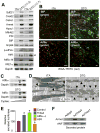A thrombospondin-dependent pathway for a protective ER stress response
- PMID: 22682248
- PMCID: PMC3372931
- DOI: 10.1016/j.cell.2012.03.050
A thrombospondin-dependent pathway for a protective ER stress response
Abstract
Thrombospondin (Thbs) proteins are induced in sites of tissue damage or active remodeling. The endoplasmic reticulum (ER) stress response is also prominently induced with disease where it regulates protein production and resolution of misfolded proteins. Here we describe a function for Thbs as ER-resident effectors of an adaptive ER stress response. Thbs4 cardiac-specific transgenic mice were protected from myocardial injury, whereas Thbs4(-/-) mice were sensitized to cardiac maladaptation. Thbs induction produced a unique profile of adaptive ER stress response factors and expansion of the ER and downstream vesicles. Thbs bind the ER lumenal domain of activating transcription factor 6α (Atf6α) to promote its nuclear shuttling. Thbs4(-/-) mice showed blunted activation of Atf6α and other ER stress-response factors with injury, and Thbs4-mediated protection was lost upon Atf6α deletion. Hence, Thbs can function inside the cell during disease remodeling to augment ER function and protect through a mechanism involving regulation of Atf6α.
Copyright © 2012 Elsevier Inc. All rights reserved.
Conflict of interest statement
Figures







Comment in
-
ATF6 [corrected] and thrombospondin 4: the dynamic duo of the adaptive endoplasmic reticulum stress response.Circ Res. 2013 Jan 4;112(1):9-12. doi: 10.1161/CIRCRESAHA.112.280560. Circ Res. 2013. PMID: 23287452 Free PMC article.
Similar articles
-
Dissection of Thrombospondin-4 Domains Involved in Intracellular Adaptive Endoplasmic Reticulum Stress-Responsive Signaling.Mol Cell Biol. 2015 Oct 12;36(1):2-12. doi: 10.1128/MCB.00607-15. Print 2016 Jan 1. Mol Cell Biol. 2015. PMID: 26459760 Free PMC article.
-
Defective Flux of Thrombospondin-4 through the Secretory Pathway Impairs Cardiomyocyte Membrane Stability and Causes Cardiomyopathy.Mol Cell Biol. 2018 Jun 28;38(14):e00114-18. doi: 10.1128/MCB.00114-18. Print 2018 Jul 15. Mol Cell Biol. 2018. PMID: 29712757 Free PMC article.
-
Assessing the contribution of thrombospondin-4 induction and ATF6α activation to endoplasmic reticulum expansion and phenotypic modulation in bladder outlet obstruction.Sci Rep. 2016 Sep 1;6:32449. doi: 10.1038/srep32449. Sci Rep. 2016. PMID: 27581066 Free PMC article.
-
Sledgehammer to Scalpel: Broad Challenges to the Heart and Other Tissues Yield Specific Cellular Responses via Transcriptional Regulation of the ER-Stress Master Regulator ATF6α.Int J Mol Sci. 2020 Feb 8;21(3):1134. doi: 10.3390/ijms21031134. Int J Mol Sci. 2020. PMID: 32046286 Free PMC article. Review.
-
Atf6α impacts cell number by influencing survival, death and proliferation.Mol Metab. 2019 Sep;27S(Suppl):S69-S80. doi: 10.1016/j.molmet.2019.06.005. Mol Metab. 2019. PMID: 31500833 Free PMC article. Review.
Cited by
-
New concepts of endoplasmic reticulum function in the heart: programmed to conserve.J Mol Cell Cardiol. 2013 Feb;55:85-91. doi: 10.1016/j.yjmcc.2012.10.006. Epub 2012 Oct 23. J Mol Cell Cardiol. 2013. PMID: 23085588 Free PMC article. Review.
-
Ceapins inhibit ATF6α signaling by selectively preventing transport of ATF6α to the Golgi apparatus during ER stress.Elife. 2016 Jul 20;5:e11880. doi: 10.7554/eLife.11880. Elife. 2016. PMID: 27435962 Free PMC article.
-
Lost in transgenesis: a user's guide for genetically manipulating the mouse in cardiac research.Circ Res. 2012 Aug 31;111(6):761-77. doi: 10.1161/CIRCRESAHA.111.262717. Circ Res. 2012. PMID: 22935533 Free PMC article. Review.
-
Integrating ER and Mitochondrial Proteostasis in the Healthy and Diseased Heart.Front Cardiovasc Med. 2020 Jan 15;6:193. doi: 10.3389/fcvm.2019.00193. eCollection 2019. Front Cardiovasc Med. 2020. PMID: 32010709 Free PMC article. Review.
-
Transcriptome analysis of collagen VI-related muscular dystrophy muscle biopsies.Ann Clin Transl Neurol. 2021 Nov;8(11):2184-2198. doi: 10.1002/acn3.51450. Epub 2021 Nov 2. Ann Clin Transl Neurol. 2021. PMID: 34729958 Free PMC article.
References
-
- Adachi Y, Yamamoto K, Okada T, Yoshida H, Harada A, Mori K. ATF6 is a transcription factor specializing in the regulation of quality control proteins in the endoplasmic reticulum. Cell Struc Func. 2008;33:75–89. - PubMed
-
- Beskow A, Grimberg KB, Bott LC, Salomons FA, Dantuma NP, Young P. A conserved unfoldase activity for the p97 AAA-ATPase in proteasomal degradation. J Mol Biol. 2009;394:732–746. - PubMed
-
- Briggs MD, Hoffman SM, King LM, Olsen AS, Mohrenweiser H, Leroy JG, Mortier GR, Rimoin DL, Lachman RS, Gaines ES, Cekleniak JA, Knowlton RG, Cohn DH. Pseudoachondroplasia and multiple epiphyseal dysplasia due to mutations in the cartilage oligomeric matrix protein gene. Nat Genet. 1995;10:330–336. - PubMed
Publication types
MeSH terms
Substances
Grants and funding
LinkOut - more resources
Full Text Sources
Other Literature Sources
Molecular Biology Databases
Research Materials
Miscellaneous

